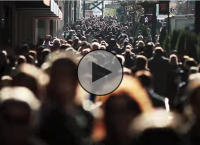Biology of the Blues: Prof. Alon Chen Studies Stress
Prof. Alon Chen of the Department of Neurobiology of the Weizmann Institute of Science explains the mechanism of stress and what happens when the system goes awry.
#ויצמן #מכוןויצמן #weizmann #weizmanninstitute #מדע #science #research #מחקר #scientist #health #medicine #biology #Neurobiology #WeizmannInstituteofScience #מכוןויצמןלמדע
Of Mice and Humans
Weizmann Institute research into mouse social behavior finds signs of leadership and reveals “autistic” mouse society
Read full story: http://wis-wander.weizmann.ac.il/mice-in-a-big-brother-setup-develop-social-structures#.VA1Xyfm1bYg
#ויצמן #מכוןויצמן #weizmann #weizmanninstitute #מדע #science #research #מחקר #scientist #scialbehaviour #society #health #medicine #WeizmannInstituteofScience #מכוןויצמןלמדע
The Handshake Experiment
Nice to Sniff You: A new Weizmann Institute study found that people sniff their hands twice as much after a handshake. Research student Idan Frumin and Prof. Noam Sobel the Neurobiology Department suggest one of the reasons for this ancient custom may provide people with a socially acceptable way of checking out each other’s odors. Click on the link to read the full story: http://bit.ly/1EJak4l #WeizmannInstituteofScience #מכוןויצמןלמדע
Dr. Nachum Ulanovsky: Using Bats to Light the Way
This 3 minute video tells the story of Weizmann Institute researcher Dr. Nachum Ulanovsky who is using bats to explore the brain's ability to locate in space. The brain areas instrumental in this skill are essential for short-term memory. Produced by the Department of Resource Development. #WeizmannInstituteofScience #מכוןויצמןלמדע
Fruit Bats Navigate With Internal Maps
To understand how bats locate individual trees night after night, scientists attached tiny GPS devices to the bats in the first-ever, comprehensive, GPS-based field study of mammal navigation. The researchers collected data as the bats took flight each night from a cave near the Israeli city of Beit Shemesh. These bats flew in a straight line at speeds of 40 km an hour and more -- up to 60 kmh -- at elevations of hundreds of meters, to trees that were about 12 to 25 km from their cave. Full Article: http://wis-wander.weizmann.ac.il/fruit-bats-navigate-with-internal-maps #WeizmannInstituteofScience #מכוןויצמןלמדע
Locally Produced Proteins
How do long nerve extensions get a crucial molecule to an injury site in time? Weizmann Institute findings may help point the way toward better treatments for nerve damage and aid in finding ways to speed up the repair.
http://wis-wander.weizmann.ac.il/locally-produced-proteins#.UbBPoEBHLXI
#ויצמן #מכוןויצמן #weizmann #weizmanninstitute #מדע #science #research #מחקר #scientist #protein #molecule #nervedamage #WeizmannInstituteofScience #מכוןויצמןלמדע
Overcoming Fear, Yadin Dudai, Ph.D and Uri Nili
What does courage look like in the brain? Weizmann scientists have discovered brain regions and activity patterns that correlate with choosing to overcome fear.
#ויצמן #מכוןויצמן #weizmann #weizmanninstitute #מדע #science #research #מחקר #scientist #courage #brain #WeizmannInstituteofScience #מכוןויצמןלמדע
A Chemical Signal in Human Tears, Prof. Noam Sobel
Emotional crying is a universal, uniquely human behavior; When we cry, we clearly send all sorts of emotional signals. In a paper published online today in Science Express, scientists at the Weizmann Institute have demonstrated that some of these signals are chemically encoded in the tears themselves. Specifically, they found that merely sniffing a woman's tears -- even when the crying woman is not present -- reduces sexual arousal in men.
http://wis-wander.weizmann.ac.il/tears-are-a-turn-off#.UlUZllCnruw
#ויצמן #מכוןויצמן #weizmann #weizmanninstitute #מדע #science #research #מחקר #scientist #humanbehaviour #chemistry #WeizmannInstituteofScience #מכוןויצמןלמדע
Thanks for the Memories
How easy is it to falsify memory? New research at the Weizmann Institute shows that a bit of social pressure may be all that is needed. The study reveals a unique pattern of brain activity when false memories are formed -- one that hints at a surprising connection between our social selves and memory.
Full article: http://wis-wander.weizmann.ac.il/thanks-for-the-memories#.UlpsOFCnruw #WeizmannInstituteofScience #מכוןויצמןלמדע
Mice in a "Big Brother" Setup Develop Social Structures
Weizmann Institute research into mouse social behavior finds signs of leadership and reveals "autistic" mouse society
Read full article: https://wis-wander.weizmann.ac.il/mice-%E2%80%9Cbig-brother%E2%80%9D-setup-develop-social-structures #WeizmannInstituteofScience #מכוןויצמןלמדע















